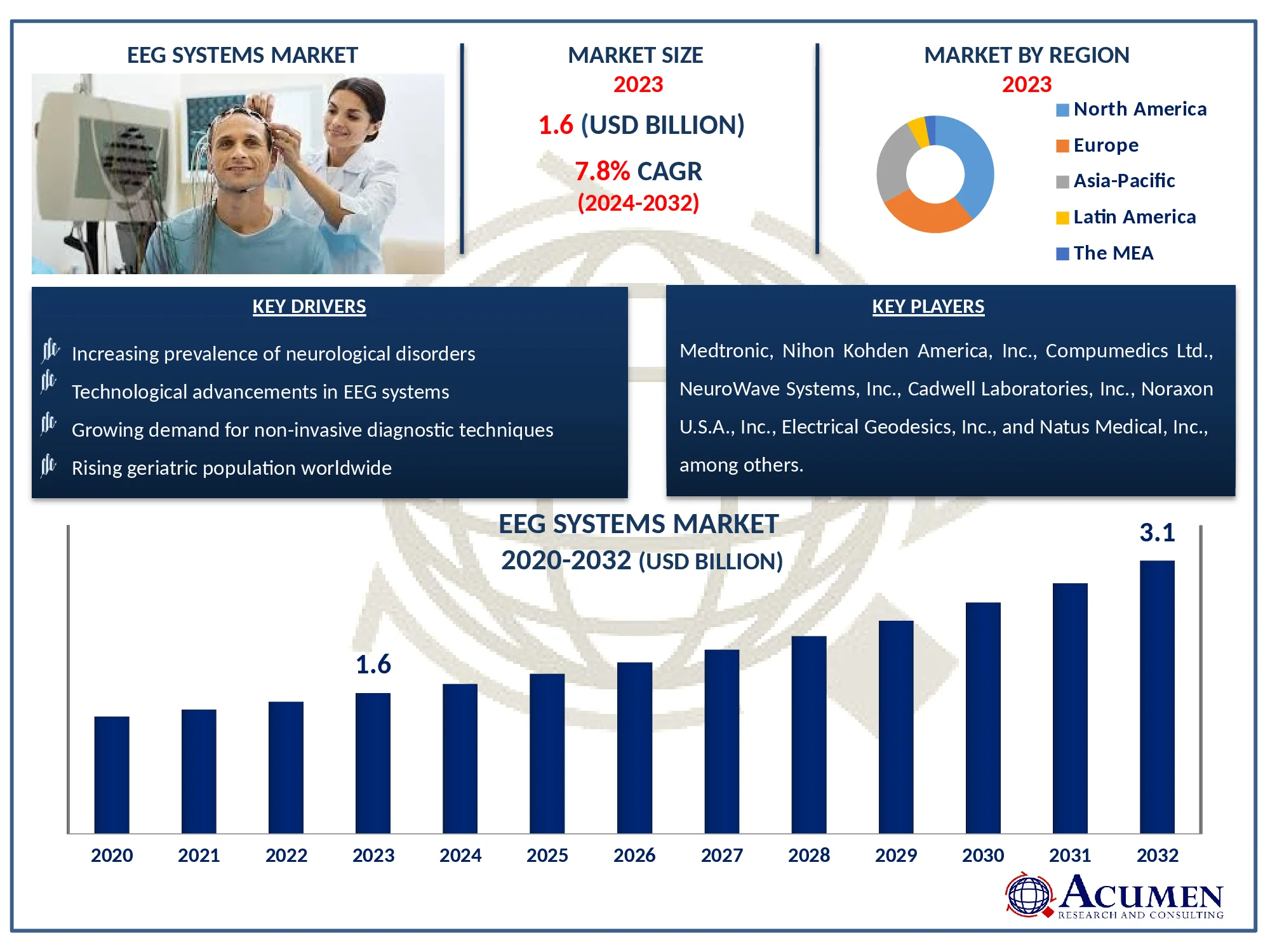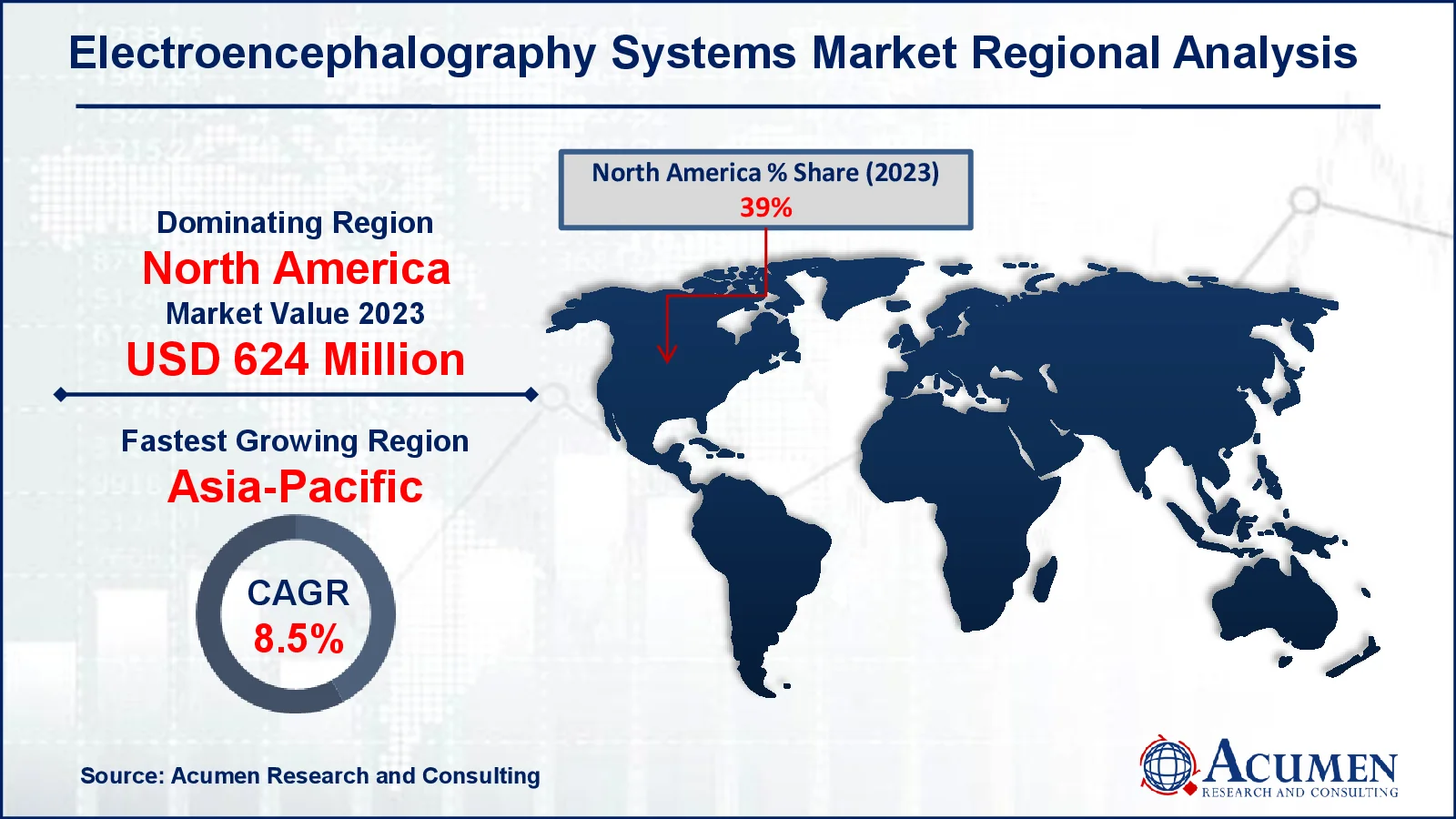March 2024
Explore the booming Electroencephalography Systems Market, expected to grow at a CAGR of 7.8% from 2024 to 2032, reaching USD 3.1 Billion by 2032. Learn more about industry trends.
The Global Electroencephalography Systems Market Size accounted for USD 1.6 Billion in 2023 and is estimated to achieve a market size of USD 3.1 Billion by 2032 growing at a CAGR of 7.8% from 2024 to 2032.
Electroencephalography Systems Market Highlights

Electroencephalography (EEG) is a method of measuring electrical activity in the human brain. EEG equipment is critical for identifying a variety of disorders involving abnormal brain activity, such as coma, disorientation, stroke, and tumors. The international EEG market is expected to increase significantly, owing to rising demand for better brain monitoring technology. Among the several modalities available, ambulatory or mobile EEG shows potential as a viable choice for companies working in the EEG device market. This is due to its accessibility and capacity to give excellent patient comfort during surgery. As technology advances, novel EEG devices are projected to drive market expansion by enhancing diagnostic capabilities and patient outcomes. The potential of mobile EEG emphasizes the significance of offering accessible and easy brain monitoring options for both healthcare practitioners and patients.
Global Electroencephalography Systems Market Dynamics
Market Drivers
Market Restraints
Market Opportunities
Electroencephalography Systems Market Report Coverage
| Market | Electroencephalography (EEG) Systems Market |
| Electroencephalography (EEG) Systems Market Size 2022 |
USD 1.6 Billion |
| Electroencephalography (EEG) Systems Market Forecast 2032 | USD 3.1 Billion |
| Electroencephalography (EEG) Systems Market CAGR During 2023 - 2032 | 7.8% |
| Electroencephalography (EEG) Systems Market Analysis Period | 2020 - 2032 |
| Electroencephalography (EEG) Systems Market Base Year |
2022 |
| Electroencephalography (EEG) Systems Market Forecast Data | 2023 - 2032 |
| Segments Covered | By Product, By Type, By End Use, And By Geography |
| Regional Scope | North America, Europe, Asia Pacific, Latin America, and Middle East & Africa |
| Key Companies Profiled | Medtronic, Nihon Kohden America, Inc., Compumedics Ltd., NeuroWave Systems, Inc., Cadwell Laboratories, Inc., Noraxon U.S.A., Inc., Electrical Geodesics, Inc., Natus Medical, Inc., Bio-Signal Group Corp., and Jordan Neuroscience Inc. |
| Report Coverage |
Market Trends, Drivers, Restraints, Competitive Analysis, Player Profiling, Covid-19 Analysis, Regulation Analysis |
Electroencephalography Systems Market Insights
Increased incidence and awareness of neurological disorders are significant contributors to development. The heightened adoption of EEG systems is propelled by the high prevalence of illnesses such as Alzheimer's, epilepsy, dementia, multiple sclerosis, Parkinson's disease, and stroke. According to data from the Alzheimer's Association, nearly 5.7 million Americans were affected by Alzheimer's in 2018, with projections indicating that over half of the population over 65 will experience dementia by 2050. Information from the ALS Association indicates that more than 5,000 Americans are diagnosed with Amyotrophic Lateral Sclerosis (ALS) each year, a number expected to double soon. Estimates from the Centers for Disease Control and Prevention (CDC) national vital statistics report reveal that stroke ranks as the fifth most common cause of death in the United States. This same data source indicates that, due to cerebrovascular diseases, the average years of prospective lives lost before the age of 75 was 187.1 in the USA. These facts underscore the growing prevalence of neurological diseases, driving demand for EEG devices for continuous surveillance and therapy.
According to the International Alzheimer's Disease (ID), Southeast Asia is projected to experience a 226% increase in Alzheimer's cases, while the African region is expected to see a 345% rise. Data from the same source also indicate that by 2050, over 106.23 million individuals globally will be afflicted with Alzheimer's disease. Consequently, the growing geriatric population worldwide, facilitated by improved healthcare systems, is fostering increased neuroscience research and development. Takeda's efforts in Alzheimer's and Parkinson's research, along with Biogen's collaborations with Pfizer and Denali Therapeutics for the development of mental health treatments for schizophrenia, are expected to positively impact market growth during the electroencephalography systems industry forecast period.
Another crucial factor driving the electroencephalography devices industry's development is the surge in R&D investments by suppliers for advanced brain surveillance equipment. For instance, Natus Medical, Inc. allocated approximately US$ 33.4 million for research and development in 2016. Companies are investing in research and technology to enhance existing products and introduce new ones to meet the rising demand for sophisticated equipment.
Electroencephalography Systems Market Segmentation
The worldwide EEG device market is split based on product, type, end use, and geography.
EEG System Market By Products
According to electroencephalography systems industry analysis, the 32-channel EEG segment was expected to maintain its dominance as the largest revenue-generating sector in 2023, and it is projected to continue leading during the forecast period. Technological advancements in 32-channel EEG products and their high levels of acceptance among healthcare professionals are the main drivers of development.
In terms of revenue, the 25-channel EEG and 40-channel EEG segments are expected to complement the 32-channel EEG segment in 2023. Products such as the Neurofax EEG-1200 Diagnostic and Monitoring Platform from Nihon Kohden Corporation are anticipated to gain popularity in the coming years, with these segments expected to witness significant growth rates during the electroencephalography systems market forecast period.
Multichannel EEG devices are utilized for recording electrical brain activity, aiding in the diagnosis and detection of tumors, neurological disorders, strokes, and other brain conditions. Companies offering these products include Compumedics Limited and Natus Medical Inc. (offering products such as NicoletOne, XLtek EEG Systems, Grael LT EEG System, and Grael 4K-EEG). This segment is expected to experience substantial growth in the electroencephalography device market forecast period.
EEG System Market By Types
In terms of electroencephalography systems market analysis, standalone devices accounted for the main market share in 2023, with standalone EEGs being the most commonly utilized. The widespread use of these instruments in critical care settings significantly contributes to their large share of revenues. Standalone EEG systems are fixed or implanted devices located in specific locations, primarily used in hospital environments. They comprise hardware and software options that enable physicians to effectively interpret results, aiding in the recording of electrical brain activity. The rising number of patients admitted for treatment in hospitals due to neurological conditions, such as tumors, cerebral palsy, strokes, and other brain-related illnesses, has primarily driven the growth of standalone instruments used in these environments.
Portable EEG equipment, by nature, can be transported and provide similar outcomes to standalone equipment. They are often used in ambulatory and other paramedic environments to assess the patient's condition, particularly when measuring the brain's electrical activity. Portable devices are also utilized in home-care settings for comatose patients and those with other neurological disorders. The portable devices segment is anticipated to experience the largest compound annual growth rate (CAGR) during the electroencephalography device market forecast period. Manufacturers are increasingly focusing on technological advancements such as portability, lightweight design, and simultaneous data acquisition. This growth segment is expected to meet the rising demand for handheld devices in clinical practice and outdoor research.
EEG System Market By End Uses
In 2023, hospital companies dominated the EEG device market due to the increasing incidence of traumatic brain injuries, epilepsy, and other neurological disorders. Furthermore, the growing focus on health infrastructure development in Asia-Pacific and African developing nations is driving the growth of this segment. Hospitals held the largest market share due to the rising admissions of patients with traumatic brain injuries, epilepsy, and other neurological conditions. Hospitals are primary end-users of EEG devices for monitoring rhythm and electrical activity, and for detailed analysis for clinical and research purposes. The high patient inflow and frequent readmissions contributed to the dominance of this segment in 2023.
The diagnostic centers segment is expected to experience the fastest growth during the study period, fueled by increasing awareness of neurodegenerative diseases. There is a growing demand for state-of-the-art EEG products for diagnosis and prevention purposes. Developed countries like the United States and Germany, with highly-developed health infrastructure, have a high demand for sophisticated diagnostic products. The other segment includes neurological centers, clinical investigation organizations, and scholarly research institutions. Neurological centers cater specifically to patients with neurological disorders, experiencing a surge in demand for diagnosis and therapy due to the increasing prevalence of neurological diseases.
EEG System Market By Regional Outlook
North America
Europe
Asia-Pacific
Latin America
The Middle East & Africa

Electroencephalography Systems Market Regional Analysis
In 2023, North America led the EEG device industry. The increasing incidence of neurological disorders, improved accessibility to insurance, and the prevalence of multiple sleep and neurodegenerative disorders significantly contributed to regional development. Additionally, projected growth drivers include highly advanced health infrastructure and the robust distribution and sales networks of major suppliers in these regions.
Due to its well-established healthcare system, Europe is expected to experience consistent growth over the electroencephalography (EEG) systems industry forecast period. Further market expansion is anticipated with the establishment of several non-consumer organizations, such as the European Multiple Sclerosis Platform (EMSP). According to the EMSP, approximately 9 million individuals in Europe are affected by neurodegenerative diseases. This organization promotes research and information dissemination related to multiple sclerosis and focuses on raising awareness in Europe and beyond, thereby fostering development.
During the electroencephalography (EEG) systems market forecast period, Asia Pacific is projected to exhibit the highest compound annual growth rate (CAGR) due to the region's expanding population. Moreover, untapped opportunities in countries like India and China, coupled with rapidly emerging healthcare infrastructure, are driving market growth.
Electroencephalography Systems Market Players
Some of the top electroencephalography systems companies offered in our report includes Medtronic, Nihon Kohden America, Inc., Compumedics Ltd., NeuroWave Systems, Inc., Cadwell Laboratories, Inc., Noraxon U.S.A., Inc., Electrical Geodesics, Inc., Natus Medical, Inc., Bio-Signal Group Corp., and Jordan Neuroscience Inc.
Looking for discounts, bulk pricing, or custom solutions? Contact us today at sales@acumenresearchandconsulting.com
March 2024
November 2023
April 2023
November 2023